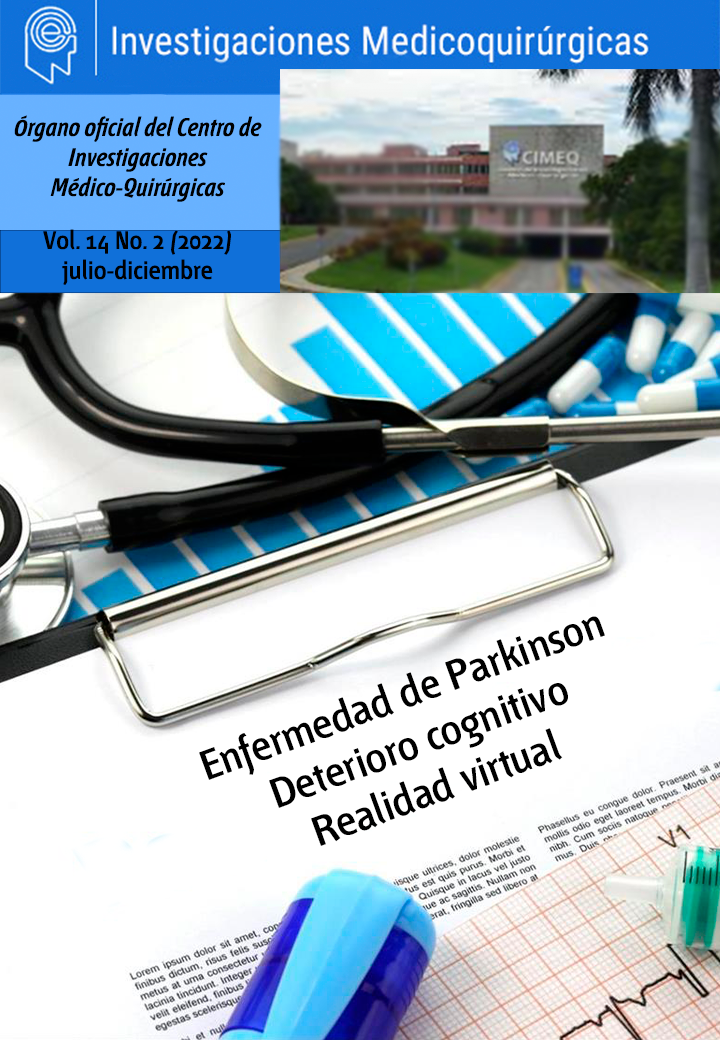Treatment with physical agents in Parkinson's disease
Keywords:
Parkinson's disease, physical agents, visual analog scaleAbstract
Introduction: In this work we address the treatment with physical agents in patients with Parkinson's disease admitted to CIREN. Parkinson's disease is a neurological disease that is found in the group of the so-called neurodegenerative of the Central Nervous System, its main symptoms include pain, stiffness, tremor, hypokinesia, gait disorders, posture and Balance Among the most effective methods and techniques for treating these patients is exercise training and the therapeutic use of different physical agents, aimed at improving the quality of life of these patients. In the Department of Physiotherapy, this approach strategy is used within the Neuro-restorative Program in order to assess the influence of physiotherapeutic intervention with physical agents in Parkinson's disease during the rehabilitation period.
Methods: A retrospective study was carried out taking a sample of 45 patients with Idiopathic Parkinson's Disease, treated with different types of physical agents, for analgesic purposes. The Visual Analog Scale (VAS) was applied to all patients at the beginning and end of treatment.
Results: the analysis of the results was analyzed with Descriptive Statistical methods and Wilcoxon test with a significance level of p <0.05.
Conclusions: there was a significant improvement in the measured parameters; all the applied treatments guaranteed a statistically significant improvement, which facilitated the favorable incorporation of the patients to the Intensive Multifactorial Rehabilitation Program.
References
Daniel Truco Uzquiano (2011)Aplicación de la fisioterapia en la enfermedad de Parkinson https://www.efisioterapia.net/articulos/aplicacion-la-fisioterapia-la-enfermedad-parkinson
Jaume Kulisevsky Bojarski, Enfermedad de Parkinson. Guía terapéutica de la Sociedad Catalana de Neurología. Fundación de la Sociedad Catalana de Neurología
J. Rotondo1, M. Toro1, M. Bolívar1,2, M. E. Seijas1 y C. Carrillo1 (2019) Dolor en la enfermedad de Parkinson. Una mirada a un aspecto poco conocido de esta patología. RevSocEsp Dolor;26(3):184-198
M. ChouzaInsua, I. Raposo Vidal, R. Fernández Cervantes, L. González Doniz, A. Martínez Rodríguez, M. A. Fernández García (2001). Protocolo de Fisioterapia en el paciente parkinsoniano Fisioterapia;23(4):191-199.
Solangel Hernández Tapanes, René Esteban Ventura Velázquez, Tania Bravo Acosta, Jorge Martín Cordero, Miriela Cabrera. Rehabilitación en la enfermedad de Parkinson. Archivo de Medicina http://www.archivosdemedicina.com
Lara Serrano Verónica.Tratamiento fisioterápico en pacientes con Parkinson Promoción (2005-2008). Escuela de Fisioterapia de la Universidad de Valencia.
Lin CH, Wu RM, Chang HY, Chiang YT, Lin HH (2013), Preceding pain symptoms and Parkinson’s disease: a nationwide population-based cohort study. Eur J Neurol.; 20(10):1398404. DOI: 10.1111/ene.12197
Downloads
Published
How to Cite
Issue
Section
License
The authors retain copyright and all unrestricted publication rights.
Medicoquirúrgicas Research is licensed under the Creative Commons Attribution-Noncommercial 4.0 International License (CC BY-NC 4.0) and follows the SciELO Publishing Schema (SciELO PS) for publishing in XML format.
You are free to:
- Share — copy and redistribute the material in any medium or format.
- Adapt — remix, transform, and build upon the material.
The license cannot revoke these freedoms as long as you follow the license terms.
Under the following terms:
- Attribution — You must give appropriate credit, provide a link to the license, and indicate if changes were made. You may do this in any reasonable manner, but not in any way that suggests the licensor endorses you or your use.
Non-Commercial — You may not use the material for commercial purposes.
No Additional Restrictions — You may not apply legal terms or technological measures that legally restrict others from making any use permitted by the license.
Notices:
You do not have to comply with the license for elements of the material in the public domain or where their use is permitted by an applicable exception or limitation.
No warranties are given. The license may not give you all the permissions you need for your intended use. For example, other rights such as publicity, privacy, or moral rights may limit how you use the material.



